We are actively seeking Alden Mason "Burpee Garden Series" paintings from
early to mid 1970s.
Press release
For Alden Mason, the 1960s had been a decade of searching for himself, working through nature and landscape paintings, then some
hard edged, flat colored paintings styled after a Pop Art sensibility, and ending with more gestural works harkening back to deKooning and
other abstract painters.
If the 1960s were about searching, the 1970s proved to be a decade of finding himself, as Mason produced some of his most memorable and
groundbreaking work.
The "Burpee Garden" series dates from 1972-73 specifically but, in sensibility, goes on to include all five years or so of these oil paintings
until 1977. The series title derives from the Burpee Seed Company catalog which Mason remembered from his early years growing up on
a farm in the Skagit Valley. These large and sumptuous works were widely viewed as triumphant innovations as Mason's career
progressed. With their audacious color, surprising scale, and exuberant abstraction, they represent a break with the somberly colored
poetic narratives that had typified painting here following the advent of the Northwest School, and artists such as Guy Anderson, Kenneth
Callahan, Morris Graves and Mark Tobey. Mason's significance is obvious in the way the "Burpee Garden" paintings mark a distinct turn
toward in that linear history. Along with other abstract artists working in Seattle such as Francis Celentano, Michael Dailey, Robert Jones,
William Ivey, Frank Okada, Michael Spafford, and Margaret Tompkins, Mason influenced the development of many younger artists here.

SOFT GARDEN, 1973
Watercolor and oil pastel on paper
40 x 48 inches
$45,000

DANDY BLUSHER, 1974
Oil on canvas
71 x 83 inches
SOLD
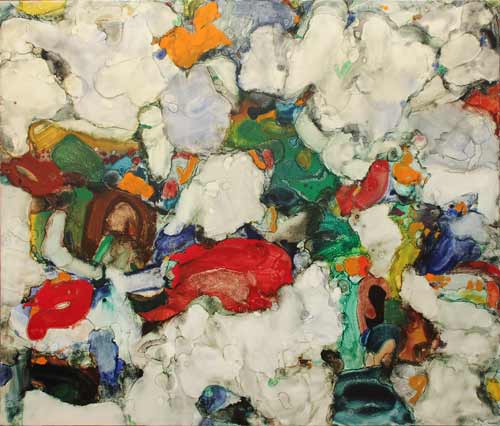
LUCKY GREEN, 1974
Oil on canvas
70 x 82 inches
SOLD

VERTICAL GARDEN, 1974
Oil on canvas
32 x 16 inches
SOLD
The special quality of these "Burpee Garden" works is understood in their lack of predictability. They are painted on a heavily gessoed canvas ground that has been sanded to a tooth similar to watercolor paper. The color is pooled and poured on, then dragged, pushed and pulled around by house painting brushes, rags, and even brooms. Positioning himself on trestles spanning the width of the sheet of canvas, the artist hovered over his paint surface, often kneeling a few inches above the surface. With this method, which belies a look of great spontaneity, Mason had surprisingly great control of his gesture and imagery, rarely showing an actual brush stroke. His brilliant, jewel-like color itself came from fine quality oil paint, thinned down with all manner of thinners, varnishes and driers. In this liquid state, the paint had become akin to watercolor and Mason dealt with it similarly- but now on a heroic scale, often about 70 x 80 inches to 80 x 90 inches. The paintings could take days to dry and he could correct a work while it was still wet by wiping it clean down to the gesso but, once dry, he didn’t make correction. There are some small works as well, but most often they are edited from larger works Mason rejected as a whole painting, while saving the "good parts" from them as separate, smaller "cut-down" works.
While many artists from Guy Anderson to Frank Stella used house painting brushes in their work, none of their work looked like Alden's.
Similarly, Jackson Pollock and others spilled, poured, flung and dripped paint, but their works are more performative than Mason's. While
painted and poured horizontally on the floor, like Helen Frankenthaler's work, they are not stains on raw canvas like hers, though he, too,
embraced the "happy accident" that came with this kind of spontaneous gesture. The paintings and drawings of this period resemble most
the works of artists like Arshille Gorky, or the Los Angeles painter, John Altoon.
By Mason's estimation, there were only about 70 - 80 of these large oil paintings painted between 1971 and 1977. As time goes by more
and more of the major works are in museum collections, making them rare in the market place. In some of the later oil paintings one can
detect loosely realized figures among the pools of color but the paintings largely remained at odds with the drawings during this period.
In 1973, following the spectacular success of his first exhibition of the "Burpee Garden" series of paintings at Seattle's Polly Friedlander
Gallery, Alden Mason visited New York at the invitation of his friend and former student Chuck Close. Close encouraged him to install a
number of his "Burpee Garden" paintings in Close's SoHo studio in the hopes of finding a dealer in New York. Notably, Close arranged for
the maverick art dealer Allan Stone to view Mason's work.
"Burpee Garden" paintings are represented in the collections of San Francisco Museum of Modern Art, Denver Art Museum, Portland Art
Museum, Seattle Art Museum, Tacoma Art Museum, Museum of Northwest Art in La Conner, Whatcom County Museum of Art, among others,
as well as corporate and private collections all across the country.
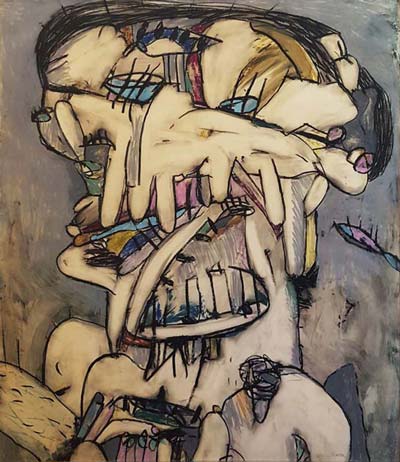
MASK WITH BLUE EYES, 1972
Oil pastel on paper
48 x 40 inches
SOLD
His drawings during this period were similarly large works, often 50 x 40 inches, using oil pastels rubbed with thinners and, while figural in nature,
contained some of the same aqueous nature of the watercolor paintings. These drawings ranged from landscapes to figure drawings, often completely overwhelmed with sexual energy and innuendo. Rock formations, seen during trips through the Southwest deserts and parks, became loopy phalluses and swollen breasts. Large head drawings suggested the notion of representation of personality and mindset but were
entirely ungrounded in the specificity of portraiture.
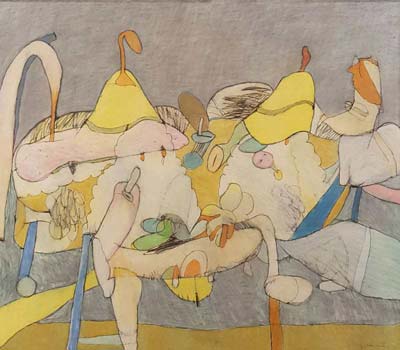
DOUBLE BREASTED LANDSCAPE, 1973
Oil pastel on paper
39.25 x 45 inches
SOLD

GREY LANDSCAPE, circa 1970s
Oil pastel on paper
21 x 18 inches
$4,500 framed
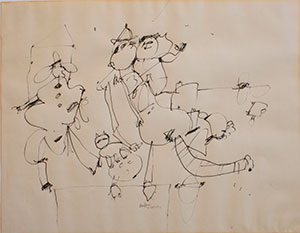
UNTITLED, circa 1970-72
Ink on paper
18 x 23 inches
$1,800
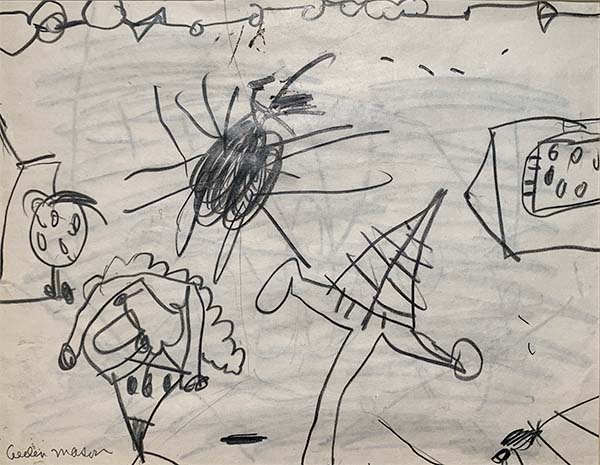
KISS GOODBYE, 1978
Graphite on paper
8 x 11 inches
$1,400
Despite his need to abandon oil painting because of its detrimental effect on his health, this short-lived series of paintings remain the
pinnacle of Mason's early success. By 1977, the toxicity of the oil paintings had ravaged the mucous membranes in his sinuses and nasal
passages. As he was literally positioned directly above the paint surface, he was breathing in large quantities of paint and thinner vapors.
He became prone to horrific headaches and was warned by his doctors to leave this dangerous, though lovely, medium behind.
Acrylic paints were the obvious choice with which to work as many other artists had embraced them over the toxic qualities inherent in oil
paints. His hope has been to continue the "Burpee" paintings in washes of acrylic paint. He began by experimenting with thin washes of
acrylic over the white surface similar to how he had used oil paint. Mason was working with very broad gestures and brushstrokes that
mimicked, but weren't convincing, as a furtherance of the "Burpee" series. He was dissatisfied with the pastel range of color. Mason began
to experiment with a black painted background. This allowed the acrylic to sit on top of the black and lose its soft, candy-like, color. He
showed these dramatic works on canvas and paper in his first show with Diane Gilson's gallery in Pioneer Square.
They were accompanied by works on paper that were more like drawings than paintings, made by dropping gobs of only slightly thinned
acrylic paint onto a paper surface, again painted black, sometimes with washes of even thinner paint over them. He would drag the paint
around with chopsticks into delicate trails of paint connecting one glob to another, often fashioning faces and heads from the white lines
and colored puddles.
Perhaps, this attention to the linear aspects, along with the use of ketchup or mustard type squeeze bottles, made him realize that the acrylic
paint could do something he hadn't done with oil paint, namely make a raised line with it. He was thrilled to see a union between his
paintings and drawings.
In 1980, his second show at Gilson's was titled the Celebration Series, as much for the breakthrough it heralded in his style, as for his new
relationship to his girlfriend, Karen Stumpf, soon to become his second wife. The paintings were joyous and, again, entirely fresh looking,
unlike what any other artist was making by using a raised line of acrylic paint as a middle ground between his painting and drawing. While
many were as small as 20 x 20 inches, others were as large as 80 x 80 inches. The raised line was used to make dizzying patterns of a
multitude of colors. Some resembled the microscopic life seen under a slide, others the fantastic patterns of Central American textiles such
as molas. Some relied on symmetry and others seemed to have no organization to their whimsical patterns whatsoever.









